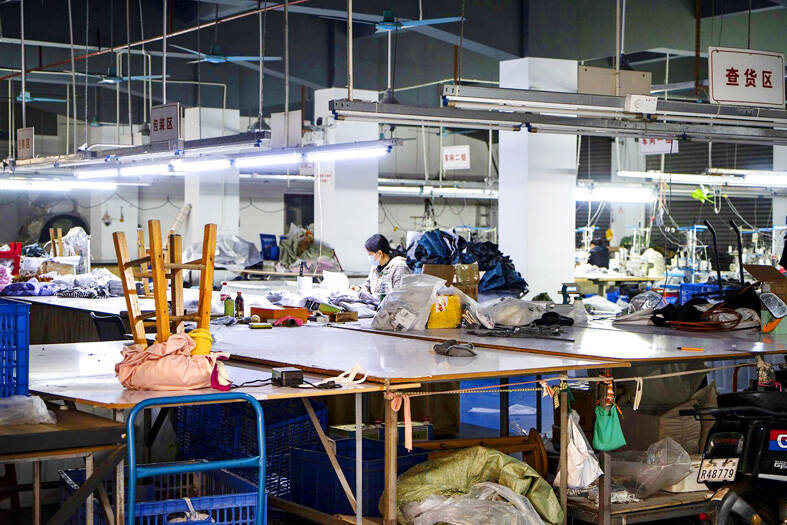China’s factory activity last month shrank for the fifth straight month, suggesting weak demand remains an obstacle for the economy.
The official manufacturing purchasing managers’ index (PMI) for last month edged lower to 49.1, the Chinese National Bureau of Statistics said in a statement yesterday.
That compares with a median forecast of 49.0 by economists surveyed by Bloomberg News and January’s reading of 49.2.

Photo: Bloomberg
A gauge of non-manufacturing activity rose to 51.4, versus an estimate of 50.7, helped by a pickup in travel and tourism during the Lunar New Year holiday.
Any reading above the 50 mark suggests an expansion from the previous month, while a figure below that denotes contraction.
Business surveys for last month contained some bright spots concentrated in the service sector, Bloomberg chief Asia economist Shu Chang said.
The question is whether the improvement is sustainable, she said, adding: “Probably not.”
The patchy data reinforce the need for further policy support, which the National People’s Congress — due to open on Tuesday — is likely to signal, Shu said.
The data added to signs of an uneven recovery in the world’s No. 2 economy. This will likely add pressure on fiscal and monetary policymakers to act after top leaders vowed to maintain a pro-growth stance this year.
China is still grappling with several key issues, including an unfolding property crisis and stubborn deflation. A recent stock market rout underscored an erosion of investor confidence, despite Beijing’s attempts to turn things around, notably by unleashing more long-term cash for banks and broadening developer access to loans.
Earlier data showed that a home sales slump dragged on last month, although the figures were also affected by the holiday break.
Pinpoint Asset Management Ltd (保銀私募基金管理) president and chief economist Zhang Zhiwei (張智威) said in an e-mail after the results that the holiday period makes it hard to “get a clear picture of economic momentum.”
“This is particularly true for the manufacturing sector,” Zhang said. “Other data points show a mixed picture, with travel data strong, but housing data weak.”
Economists expect Chinese President Xi Jinping’s (習近平) government to announce a fairly ambitious growth goal for this year when the legislature meets next week.
Accomplishing that would be tougher this year than last year as the economy benefited then from the post-pandemic reopening.
Also, yesterday, the Caixin manufacturing PMI rose to 50.9 from 50.8 in January, beating an estimate of 50.7.
The private survey, which covers mainly smaller and export-
oriented businesses, is usually more upbeat than the official readings.
Goldman Sachs Group Inc said in a note that the “fact that the significant divergence between the two manufacturing PMIs has lasted for four months in a row may be a sign of structural shifts in the economy.”
The analysts did not elaborate on those shifts.

Power supply and electronic components maker Delta Electronics Inc (台達電) yesterday said second-quarter revenue is expected to surpass the first quarter, which rose 30 percent year-on-year to NT$118.92 billion (US$3.71 billion). Revenue this quarter is likely to grow, as US clients have front-loaded orders ahead of US President Donald Trump’s planned tariffs on Taiwanese goods, Delta chairman Ping Cheng (鄭平) said at an earnings conference in Taipei, referring to the 90-day pause in tariff implementation Trump announced on April 9. While situations in the third and fourth quarters remain unclear, “We will not halt our long-term deployments and do not plan to

‘SHORT TERM’: The local currency would likely remain strong in the near term, driven by anticipated US trade pressure, capital inflows and expectations of a US Fed rate cut The US dollar is expected to fall below NT$30 in the near term, as traders anticipate increased pressure from Washington for Taiwan to allow the New Taiwan dollar to appreciate, Cathay United Bank (國泰世華銀行) chief economist Lin Chi-chao (林啟超) said. Following a sharp drop in the greenback against the NT dollar on Friday, Lin told the Central News Agency that the local currency is likely to remain strong in the short term, driven in part by market psychology surrounding anticipated US policy pressure. On Friday, the US dollar fell NT$0.953, or 3.07 percent, closing at NT$31.064 — its lowest level since Jan.

The US dollar was trading at NT$29.7 at 10am today on the Taipei Foreign Exchange, as the New Taiwan dollar gained NT$1.364 from the previous close last week. The NT dollar continued to rise today, after surging 3.07 percent on Friday. After opening at NT$30.91, the NT dollar gained more than NT$1 in just 15 minutes, briefly passing the NT$30 mark. Before the US Department of the Treasury's semi-annual currency report came out, expectations that the NT dollar would keep rising were already building. The NT dollar on Friday closed at NT$31.064, up by NT$0.953 — a 3.07 percent single-day gain. Today,

The New Taiwan dollar and Taiwanese stocks surged on signs that trade tensions between the world’s top two economies might start easing and as US tech earnings boosted the outlook of the nation’s semiconductor exports. The NT dollar strengthened as much as 3.8 percent versus the US dollar to 30.815, the biggest intraday gain since January 2011, closing at NT$31.064. The benchmark TAIEX jumped 2.73 percent to outperform the region’s equity gauges. Outlook for global trade improved after China said it is assessing possible trade talks with the US, providing a boost for the nation’s currency and shares. As the NT dollar